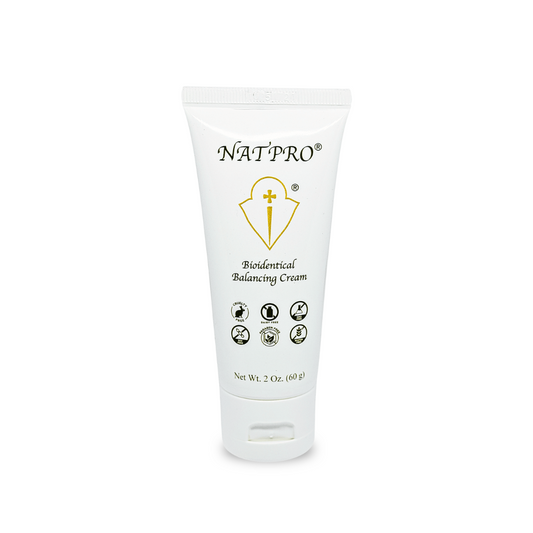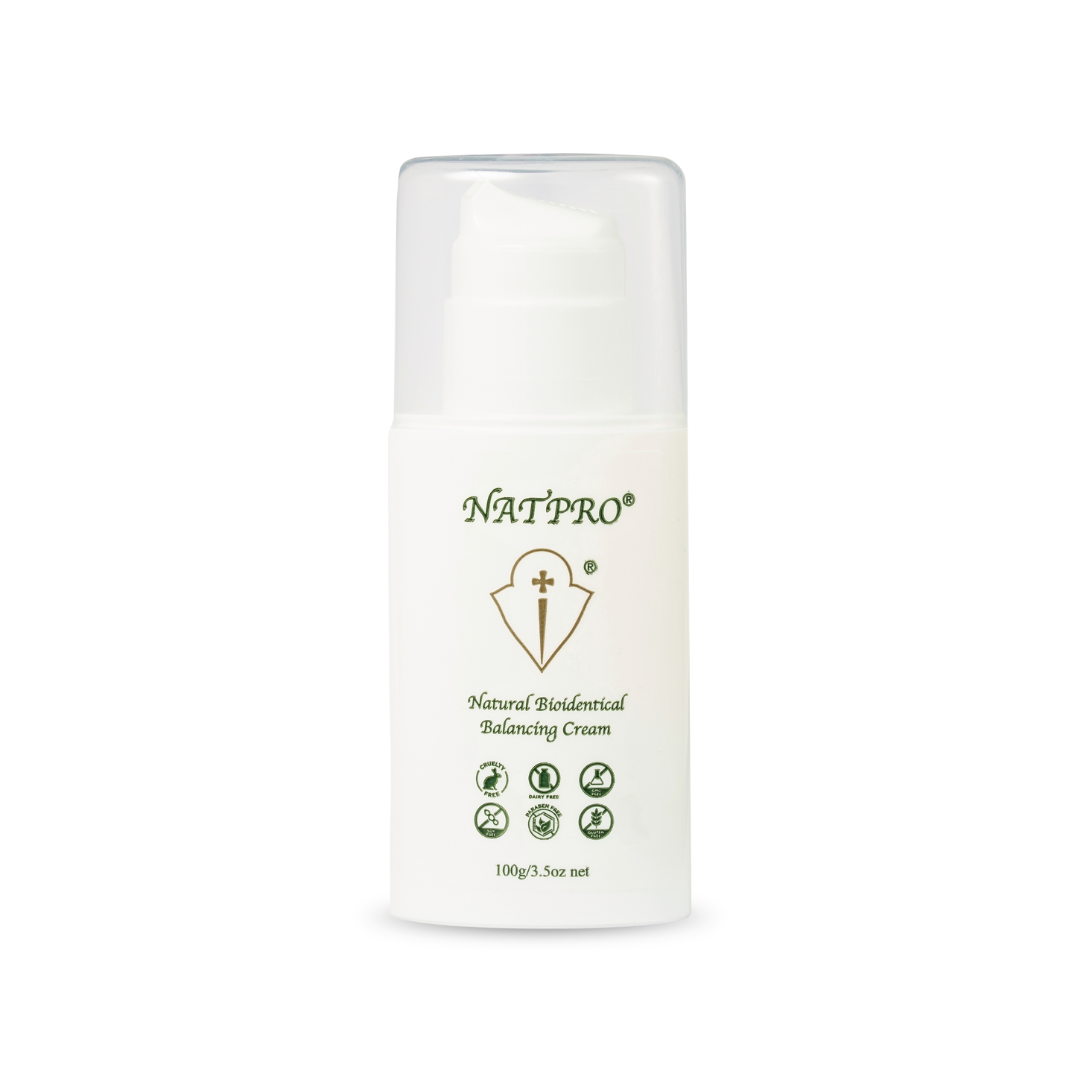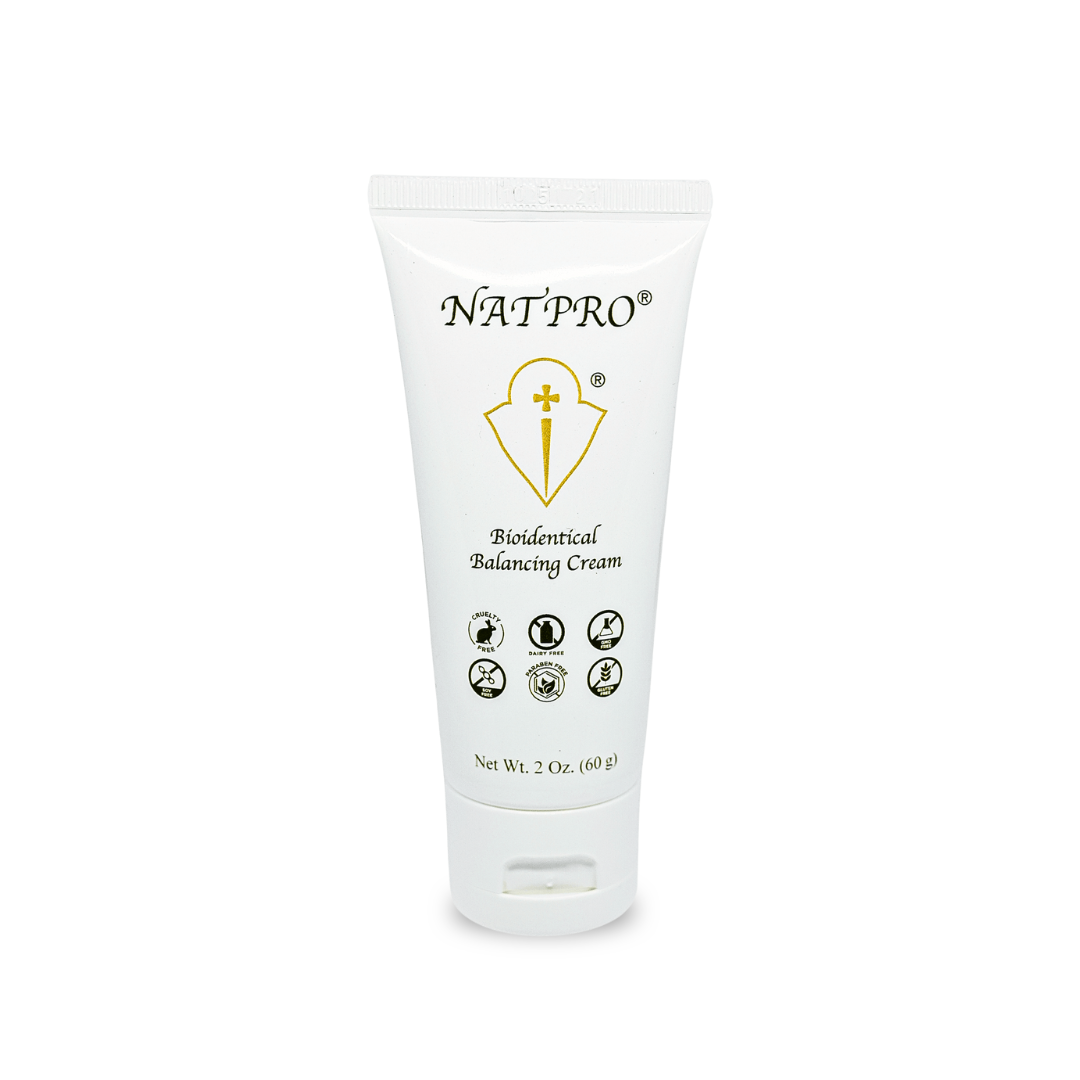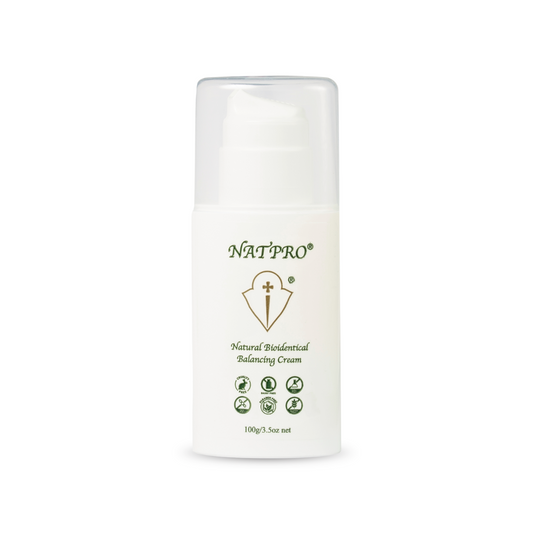
Natpro
Vollkommen natürliche, bioidentische Progesteroncreme
Ausgewählte Produkte
-
Natpro-Spender
Normaler Preis $42.90 USDNormaler Preis -
 Ausverkauft
AusverkauftNatpro Tube
Normaler Preis $25.70 USDNormaler Preis
Natpro Facts..
USP progesterone
- The progesterone in Natpro is identical to the progesterone your body makes.
- The USP progesterone in Natpro is derived from the Mexican Wild Yam. Don't confuse Natpro progesterone cream with a bean or yam "extract". Such extracts do not contain progesterone.
- Natpro has a progesterone concentration of 3.33%. This means there are 33.33 milligrams of progesterone per gram of cream.
PEG free
PEG stands for polyethylene glyco. It’s found in many formulas and has been causing some concern in recent times as a potential health hazard.
Paraben free
We use Aspen bark extract as a natural organic preservative. It is an effective replacement for commonly used chemical preservatives such as the parabens.
Soy, gluten & dairy free
- The USP progesterone in Natpro is derived from the Mexican Wild Yam not Soy.
(Don't confuse Natpro progesterone cream with a wild yam extract cream. Such creams do not contain progesterone.)
- There is no gluten or dairy used in our formula.
GMO free
We do not use any genetically modified ingredients in our Natpro formula.
Cruelty free
No animal has suffered or will ever suffer because of Natpro production.

Anwendung: Natpro Dispenser
1 Pumpstoß aus dem Spender gibt Ihnen 50 mg Progesteron
Empfohlene tägliche Basisdosis zwischen:
100 mg = 2 Pumpstöße
Und
200 mg = 4 Pumpstöße
•Verwenden Sie die Hälfte der Dosis morgens und die andere Hälfte abends.•
Die Einnahme der üblicherweise empfohlenen 20–40 mg/Tag verschlimmert die Symptome der Östrogendominanz nur.
Verwenden Sie zunächst 100–200 mg, um ein Gleichgewicht zu erreichen, und steigern Sie dann die Dosis, die für Ihren Körper geeignet ist.
Bei stärkeren Symptomen erhöhen Sie die Dosis auf 400–600 mg, bis die Symptome abklingen. Reduzieren Sie die Dosis langsam, sobald die Symptome abgeklungen sind.

Anwendung: Natpro Tube
1 TL (5 ml) Natpro gibt Ihnen 166 mg Progesteron.
Empfohlene tägliche Basisdosis zwischen:
100 mg = 3 ml Natpro-Creme
und
200 mg = 6 ml Natpro-Creme
•Verwenden Sie die Hälfte der Dosis morgens und die andere Hälfte abends.•
Die Einnahme der üblicherweise empfohlenen 20–40 mg/Tag verschlimmert die Symptome der Östrogendominanz nur.
Verwenden Sie zunächst 100–200 mg, um ein Gleichgewicht zu erreichen, und steigern Sie dann die Dosis, die für Ihren Körper geeignet ist.
Bei stärkeren Symptomen erhöhen Sie die Dosis auf 400–600 mg, bis die Symptome abklingen. Reduzieren Sie die Dosis langsam, sobald die Symptome abgeklungen sind.
So verwenden Sie Natpro für:
Vorpubertäre Phase
Es wird Frühgeborenen und Frühgeborenen mit Atemnotsyndrom verabreicht . Es wirkt beruhigend und lindert Schlafprobleme bei Babys und Kindern. Babys werden neun Monate vor der Geburt darin gebadet.
Natürliches Progesteron ist das einzige Hormon, das weder bei männlichen noch weiblichen Babys oder Kindern negative Auswirkungen hat. Sollte es also bei einem Erwachsenen zu einer Reizung kommen, entsteht kein Schaden. Im Gegensatz zu Testosteron oder Östrogen, die bei männlichen oder weiblichen Babys oder Kindern schwerwiegende Nebenwirkungen verursachen.
Nur wenn Progesteron bei einem Säugling oder Kind angewendet wird, kommt es auf die Größe an.
1 mg Progesteron oder eine stecknadelkopfgroße Menge Creme kann bei Säuglingen angewendet werden,
ältere Kinder verwenden 5–10 mg.
Es muss nur verwendet werden, um dem Kind das Überwinden einer schwierigen Stelle zu erleichtern.
Es hilft bei den negativen Symptomen, die vor der Pubertät auftraten und die während der Pubertät auftreten.
Menarche
Die Menstruation beginnt etwa zwei Jahre nach Beginn der Pubertät und wird als Menarche bezeichnet.
In diesen zwei Jahren kann es zu Stimmungsschwankungen, Wutanfällen, trotzigem Verhalten, Hautausschlägen und mehr kommen. Der Östrogen- und Testosteronspiegel steigt, aber erst mit der Menarche und dem damit verbundenen Eisprung beginnt die Progesteronproduktion.
Abhängig von den Symptomen sollten 100–200 mg Progesteron pro Tag verwendet werden.
Da kein Zyklus folgt, kann das Progesteron täglich angewendet werden, bis ein Zyklus beginnt.
Heavy / continual bleeding
It is essential to use a high amount of progesterone if menorrhagia or excessive, continual bleeding is a problem.
Between 400-600mg/day is normally needed. If the bleeding is continual, use it
both daily and hourly. Using it hourly keeps the level high throughout the day.
If there is a menstruation cycle, it is best to ignore it and use the progesterone daily, hourly too, until the bleeding is under control. The progesterone can be used to regulate the cycle once bleeding has stopped.
You should expect to see results in 4 - 7 days on the high dose though sometimes it may take longer.
Once symptoms have eased the amount can be reduced very slowly. Whenever you reduce the dose, always do so slowly over a few weeks to negate symptoms flaring up again. As a guide reduce by 20mg per week. Reducing slowly allows your body to calibrate gently - giving you time to register the changes and how your body is responding to the current dose.
If you do not reduce slowly over a few weeks adverse symptoms may return. If they do you will need to increase the dose incrementally again by 20mg until you find the dose that stabilises symptoms.
A progesterone cream can be used anywhere on the body, it does not have
to be applied to the thin skinned areas only. The skin comprises 95% kerotinocytes, these have ample progesterone receptor sites.
If the heavy bleeding occurs during Peri-menopause, the progesterone will stop it, but will not regulate the cycle again.
Women are often given progestins to stop the bleeding, but these suppress progesterone production and come with adverse side effects, please see our page on Contraceptives.
Supporting factors:
The amino acid N-acetyl cysteine is a powerful antioxidant, which can help control the bleeding as it inhibits matrix metalloproteinases. Consider taking 2000mg/day. Start taking 500mg/day and then slowly work up to 2000mg/day over one or two weeks to allow your body to adjust.
Vitamin D is essential for the normal functioning of all cells, and to prevent early commencement of the menstruation cycle. Have a blood test done to check the level. For more information visit:
Blood levels should be 70-100ng/ml or 175-250nmol/L and not the 30ng/ml or 75nmol/L most labs and doctors regard as adequate. The minimum daily dose should be 5000iu's per day, although the latest research indicates it should be 10,000iu's per day, see here.
Taurine is another powerful antioxidant. Low levels have been found in women with endometrial cancer, cystic endometrial hyperplasia, fibromyoma (fibroids), and dysfunctional uterine bleeding. Consider taking 2000mg/day.
Bioflavonoids have been found to strengthen capillaries. They appear to be weakened in heavy and/or continual bleeding or spotting. The preparation that was used in the study
comprised 90% diosmin and 10% hesperidin. Consider taking 1000mg/day.
Complete Heavy Bleeding Protocol:
- 400-600mg Natpro per day
- 2000mg N-Acetyl-Cysteine (NAC) per day
- 2000mg Taurine per day
- 5000iu's Vitamin D3 per day
- 1000mg Bioflavanoids per day
You are encouraged to refer any health problem to a health care practitioner and, in reference to any information contained in this website, preferably one with specific
knowledge of progesterone therapy
Fortpflanzungsphase
Dies dauert von der Menarche bis zur Perimenopause, wenn die Fruchtbarkeit abzunehmen beginnt.
Eine normale Zykluslänge variiert zwischen 21 und 35 Tagen, wobei durchschnittlich 28 Tage vorliegen. Aus diesem Grund verpacken Hersteller von Verhütungsmitteln und Hormonersatztherapien ihre Produkte in Chargen von 28 Tagen.
Zyklen außerhalb dieses Bereichs gelten im Allgemeinen als abnormal. Weitere Informationen hierzu finden Sie auf den Seiten zu Menstruation und PCOS.
Bei allen Frauen findet der Eisprung unabhängig von der Länge ihres Zyklus 12–14 Tage vor der Blutung statt.
Diese Phase des Zyklus wird als Luteal- oder Sekretionsphase bezeichnet.
Während der Lutealphase, also vom Eisprung bis zur Blutung, sollte Progesteron eingenommen werden, um einen eventuellen Mangel auszugleichen.
Der Mangel kann durch eine gestörte Lutealphase oder anovulatorische Zyklen verursacht werden. Diese beginnen etwa im Alter von 35 Jahren, und zu diesem Zeitpunkt verschlechtern sich bei vielen Frauen die PMS-Symptome.
Es sollten 100–200 mg Progesteron pro Tag verwendet werden, bei schweren Symptomen auch mehr.
Normale Zykluslängen
Jeder, auch die Ärzteschaft, geht davon aus, dass die normale Zykluslänge bei allen Frauen immer 28 Tage beträgt. Das ist schlichtweg falsch.
Sie variiert zwischen 21 und 35 Tagen, sodass der Durchschnitt lediglich bei 28 Tagen liegt.
Es ist ein grundlegender Fehler, Frauen zu raten, am 14. Tag mit der Einnahme von Progesteron zu beginnen. Dies ist nur für Frauen mit einem 28-Tage-Zyklus angemessen.
Bei einem 21-tägigen Zyklus bedeutet der Beginn am 14. Tag, dass sie eine Woche nach dem Eisprung mit der Einnahme von Progesteron beginnt. Sie nimmt dann nur noch 7 Tage lang Progesteron ein, bevor die Blutung einsetzt.
Ebenso würde eine Frau mit einem 35-Tage-Zyklus eine Woche vor dem Eisprung mit der Einnahme von Progesteron beginnen.
wodurch die Erkrankung wirksam gestoppt werden könnte. Anschließend würde sie 21 Tage lang Progesteron einnehmen.
Progesteron sollte immer ab dem Eisprung, also in den letzten 12–14 Tagen des Zyklus, verwendet werden.
Oder wenn Sie schwanger werden möchten, kann die Einnahme während des 50-stündigen Eisprungs vor dem Eisprung erfolgen.
Progesteron kann während der Einnahme von Medikamenten verwendet werden Verhütungsmittel. Es sollte bei der Einnahme der zweiten Hälfte der Packung verwendet werden.
Progesteron kann sicher mit jedem Medikament verwendet werden, es gibt keine Kontraindikationen
Perimenopause
Normalerweise beginnt die Menopause 5 bis 10 Jahre vor der Menopause. Als grobe Richtlinie gilt, dass Frauen etwa im gleichen Alter wie ihre Mütter in die Menopause kommen.
Mit dem Eintritt in die Perimenopause kommt es zu keinen signifikanten Veränderungen, wie etwa dem Beginn der Blutung in der Pubertät oder dem Ausbleiben der Blutung in den Wechseljahren.
Viele Frauen haben überhaupt keine Symptome, viele jedoch auch, manche sogar sehr stark. Der Progesteronspiegel sinkt, und zwar immer schneller. Dies ist auf die zunehmende Häufigkeit anovulatorischer Zyklen zurückzuführen.
Etwa ein bis zwei Jahre vor den Wechseljahren können die Zyklen sehr unregelmäßig werden. Alle zwei Wochen oder im Abstand von drei Monaten kommt es zu Blutungen, die nicht vorhersehbar sind. Die Blutung kann von Schmierblutungen über eine normale Periode bis hin zu Überflutungen variieren.
Es sollten 100–200 mg Progesteron pro Tag verwendet werden, bei schweren Symptomen auch mehr.
Sobald die Zyklen unregelmäßig werden und nicht mehr eingehalten werden können, ist es am besten, den Zyklus zu unterbrechen und täglich Progesteron während der Blutung einzunehmen. Dies ist unbedenklich. Weitere Informationen finden Sie unter Missverständnisse zu Progesteron.
Ironischerweise wird Frauen, die ständig Verhütungsmittel einnehmen, von denen einige nur Gestagene enthalten, keine Vorsicht walten gelassen.
Menopause
Diese beginnt im Durchschnitt im Alter von 51 Jahren. Es ist normal, ein Jahr zu warten, bevor man den Beginn der Wechseljahre beurteilt. Viele Frauen glauben, dass ihre Probleme mit den Wechseljahren vorbei sind, aber das ist oft nicht der Fall.
Der Eisprung hat aufgehört, die Produktion von Progesteron und Östrogen in den Eierstöcken hat aufgehört. Die Fettzellen scheiden jedoch bis zum Tod weiterhin Östron aus, das Wechseljahresöstrogen.
Leider kommt es nicht zu einer kompensatorischen Progesteronsekretion.
Viele Frauen lassen ihren Östrogenspiegel testen und erhalten die Meldung, er sei niedrig. Gemessen wird jedoch Östradiol, das Östrogen vor der Menopause, und nicht Östron, das ab der Menopause ausgeschüttet wird.
Der Östradiolspiegel sollte niedrig sein und zwischen 0 und 30 pg/ml (0 und 110,13 pmol/l) liegen. Weitere Informationen finden Sie auf unserer Seite zum Thema Hormontests .
Es sollten 100–200 mg Progesteron pro Tag verwendet werden, bei schweren Symptomen auch mehr.
Da es keinen Zyklus gibt, dem man folgen kann, verwenden Sie täglich Progesteron. Viele Frauen sind
Es wird empfohlen, eine Pause einzulegen, dies ist jedoch nicht erforderlich. Weitere Informationen finden Sie unter Missverständnisse über Progesteron .
Ironischerweise werden Frauen, die kontinuierlich eine Hormonersatztherapie (HRT) einnehmen, nicht vorgebeugt.
Frauen, die in den Wechseljahren zum ersten Mal mit der Einnahme von Progesteron beginnen, können eine Periode erleben, selten auch zwei. Das ist kein Grund zur Beunruhigung.
Im Laufe der folgenden Monate oder Jahre reicht die geringe Menge an Östrogen, die von den Fettzellen ausgeschüttet wird, aus, um die Gebärmutterschleimhaut aufzubauen oder zu verdicken. Das Progesteron reinigt die Gebärmutter effektiv.
Die Blutung tritt meistens im ersten Jahr der Menopause auf, es ist jedoch bekannt, dass Frauen im 12. Jahr der Menopause ihre Periode bekommen, wenn sie zum ersten Mal Progesteron einnehmen.
Post-menopause
Post menopausal women have naturally low progesterone levels and are still subjected to the same endocrine disruptors as everyone else, further increasing estrogen levels and contributing to adverse symptoms.
100-200mg/day progesterone should be used daily.
Use half the dose in the morning and half in the evening to maintain levels.
If symptoms are severe increase the dose to between 400 - 500mg/day. You should expect to see results in 4 - 7 days on the high dose though sometimes it may take longer.
Once symptoms have eased the amount can be reduced. Whenever you reduce the dose, always do so slowly over a few weeks to negate symptoms flaring up again. As a guide reduce by 20mg per week. Reducing slowly allows your body to calibrate gently - giving you time to register the changes and how your body is responding to the current dose.
If you do not reduce slowly over a few weeks adverse symptoms may return. If they do you will need to increase the dose incrementally again by 20mg until you find the dose that stabilises symptoms.
If you have just started using progesterone it has been known for women 12 years into menopause to have a period when first using progesterone. This is nothing to be alarmed about. Over the course of the proceeding months or years the small amount of estrogen being secreted by fat cells is enough to build or thicken the uterine lining. The progesterone is effectively cleaning out the uterus.
If you are experiencing spotting and you are post menopausal seek medical care to rule out pathology.
If there is no pathological reason found, use between 100 - 200mg/day to help with the spotting.
Increase the dose to 400mg if needed and maintain this for 4-6 days before reducing the dose very slowly over the course of a few weeks until you find a dose that manages your symptoms effectively.
A progesterone cream can be used anywhere on the body, it does not have
to be applied to the thin skinned areas only. The skin comprises 95% kerotinocytes, these have ample progesterone receptor sites.
For more in-depth information visit our page Progesterone Therapy.
You are encouraged to refer any health problem to a health care practitioner and, in reference to any information contained in this web site, preferably one with specific
knowledge of progesterone therapy.
Hysterectomy
By removal of the uterus and possibly the ovaries, a woman goes into instant menopause. If the ovaries are not removed at the same time as the uterus, they will generally atrophy within two to three years.
In the recent past, following a hysterectomy, women were usually given HRT. However, with the publication of studies finalized in 2004, which proved beyond doubt that HRT can cause an increase in cancer (particularly breast cancer), stroke and heart disease, this practice has declined. Unfortunately few medical practitioners recommend progesterone regardless of the clear connection between progesterone and menopause.
100-200mg/day progesterone should be used daily.
Use half the dose in the morning and half in the evening to maintain levels.
If symptoms are severe increase the dose to between 400 - 500mg/day. You should expect to see results in 4 - 7 days on the high dose though sometimes it may take longer.
Once symptoms have eased the amount can be reduced. Whenever you reduce the dose, always do so slowly over a few weeks to negate symptoms flaring up again. As a guide reduce by 20mg per week. Reducing slowly allows your body to calibrate gently - giving you time to register the changes and how your body is responding to the current dose.
If you do not reduce slowly over a few weeks adverse symptoms may return. If they do you will need to increase the dose incrementally again by 20mg until you find the dose that stabilises symptoms.
As there is no cycle to follow, use progesterone daily. Many women are
advised to take a break, but it's not necessary. For more information see Progesterone misconceptions.
Ironically no caution is given to women who take HRT continually.
A progesterone cream can be used anywhere on the body, it does not have
to be applied to the thin skinned areas only. The skin comprises 95% kerotinocytes, these have ample progesterone receptor sites.
You are encouraged to refer any health problem to a health care practitioner and, in reference to any information contained in this web site, preferably one with specific
knowledge of progesterone therapy.
Hot Flashes
Under normal circumstances, women require 100-200mg/day progesterone, unless symptoms are severe.
Hot flushes, once started, only respond to levels of 400mg/day and over.
For severe hot flushes use 400 - 600mg progesterone per day. You should expect to see results in 4 - 7 days on the high dose though sometimes it may take longer.
Once symptoms have eased the amount can be reduced. Whenever you reduce the dose, always do so slowly over a few weeks to negate symptoms flaring up again. As a guide reduce by 20mg per week. Reducing slowly allows your body to calibrate gently - giving you time to register the changes and how your body is responding to the current dose.
If you do not reduce slowly over a few weeks adverse symptoms may return. If they do you will need to increase the dose incrementally again by 20mg until you find the dose that stabilises symptoms.
Men generally need 10-100mg/day progesterone, but 100mg/day and over will be needed to stop hot flushes.
A progesterone cream can be used anywhere on the body, it does not have
to be applied to the thin skinned areas only. The skin comprises 95% kerotinocytes, these have ample progesterone receptor sites.
For more informaiton see our page Cure for Hot Flushes
You are encouraged to refer any health problem to a health care practitioner and, in reference to any information contained in this web site, preferably one with specific
knowledge of progesterone therapy.
PCOS
A lack of vitamin D is found in PCO, with many authorities believing it could be the main contributing factor. A lack also leads to hyperparathyroidism which is often present in PCO. High levels of parathyroid hormone suppresses thyroid activity, leading to a higher than normal TSH level. The year round level of vitamin D should be 50ng/ml (125nmol/L) or higher.
Take a minimum of 5000 IU's Vitamin D per day, bringing the level in the blood to 50ng/ml (125nmol/L) or above.
Use between 150-250mg of progesterone per day
It should only be used at ovulation, for the last 14 days of the cycle, taking day 1 as the first day of bleeding.
Cycles can be very erratic or non-existent in PCO, if this is the case use a 28 day cycle to begin with, until the natural cycle exerts itself. This would mean using the cream from day 15 to 28. For more information please see this web page on how to use progesterone.
If symptoms are severe, please consider using the progesterone daily, through any bleeding that might occur. Do this for at least 3 months, before following the cycle once again. A scan will confirm if the cysts are being absorbed back into the body.
If after the 3 months the scan confirms the cysts are going, a cycle can be started using the progesterone following a 28 day cycle. This should prevent any further cysts developing and hopefully initiate ovulation.
If there is a cycle, but with spotting before a full period, between 200-250mg of progesterone will be needed during the last 14 days to prevent the spotting. The spotting is a sign that the progesterone level is dropping too low, too soon, to support the
endometrium.
Stress drops progesterone levels sharply so symptoms come back. Increase the amount used if stress should occur.
A progesterone cream can be used anywhere on the body, it does not have
to be applied to the thin skinned areas only. The skin comprises 95% kerotinocytes, these have ample progesterone receptor sites.
It's essential to take the necessary antioxidants, L-arginine and N-acetyl cysteine too. Take 500mg of each per day. Studies have shown these antioxidant amino acids restore gonadal function. Consult with your healthcare provider to establish
You are encouraged to refer any health problem to a health care practitioner and, in reference to any information contained in this web site, preferably one with specific
knowledge of progesterone therapy.
Breast cysts
The amount of progesterone will be dependent on the individual and the
severity of the problem.
Between 100-200mg/day of progesterone should be used.
In severe cases use 400 - 500mg/ day.
Use half the dose in the morning and half in the evening
Apply the progesterone cream directly to the breasts.
When dealing with breast cysts it's essential to keep dopamine levels up to inhibit prolactin production. Adding more protein to your diet will assist. Alternatively take 250mg/day tyrosine in the morning. This requires vitamin B3 and folic acid for conversion, so take 100mg B3 and 300mcg folic acid. Gradually increase the tyrosine dose until the optimum is found. It is safe to go up to 6000mg/day. There's no need to increase the B vitamins.
Excess oestrogen can also be reduced by Calcium D-glucarate. Oestrogen is metabolised in the liver by glucuronic acid, the process is known as 'glucuronidation'. The process also removes other substances, including toxins, drugs, bilirubin, androgens, mineralocorticoids and glucocorticoids.
It is then excreted in the bile, but an enzyme in the intestine called beta-glucuronidase breaks the oestrogen/glucuronide bond, which allows oestrogen to be reabsorbed. There's evidence beta-glucuronidase activity is increased in breast and prostate cancer. Calcium D-glucarate inhibits beta-glucuronidase. See here and here.
Another supplement worth taking is DIM(diindolylmethane). Oestrogen is broken down into two principle metabolites, 2-hydroxyestrone (2-OHE1) and 16-alpha hydroxyestrone (16alpha-OHE1).
16alpha-OHE1 is regarded as a potent oestrogen, whereas 2-OHE1 is a weak oestrogen. DIM increases levels of 2-OHE1, by doing so it also increases the ratio of 2-OHE1:16alpha-OHE1. This increased ratio is
associated with a lower risk for breast cancer.
Check for an iodine deficiency, and if found take chelated iodine or Lugol's Iodine. You can also rub the Lugol's Iodine directly onto the breast.
You are encouraged to refer any health problem to a health care practitioner and, in reference to any information contained in this web site, preferably one with specific
knowledge of progesterone therapy.
Ovarian Cysts
Ovarian cysts are abnormal sacs filled with liquid or semi-solid matter found in the ovary. They can vary in size from one or two centimetres to ten or more centimetres.
Almost all pre-menopausal women will have them at some time or another, but only about 15% of menopausal women experience them.
Cysts can occur as a result of excessive stimulation by follicle stimulating hormone (FSH), or luteinising hormone (LH), or a sensitivity to these gonadotrophins.
To address this imbalance progesterone is essential, so are vitamin D and other
antioxidants. The cyst/s are normally reabsorbed within three to six months, with continued use of progesterone and antioxidants they will not return.
Use between 100-200mg/day of progesterone, half the dose in the morning, half in the evening.
You can choose to use the progesterone with your cycle if you are still menstruating or you can use the progesterone daily and not follow your cycle to neutralise the imbalance and cysts more rapidly.
A progesterone cream can be used anywhere on the body, it does not have
to be applied to the thin skinned areas only. The skin comprises 95% kerotinocytes, these have ample progesterone receptor sites.
Vitamin D is essential for normal ovarian function, in particular ovulation. A lack is behind oxidative stress, PCOS and it reduces the benefits of progesterone. A test should be done to check blood levels and a minimum of 5000iu's per day should be taken. Consider taking 1600mg/day arginine and 1200mg/day cysteine. Both these amino acids are potent antioxidants.
For more information see our page on Ovarian Cysts.
You are encouraged to refer any health problem to a health care practitioner and, in reference to any information contained in this web site, preferably one with specific
knowledge of progesterone therapy.
Extremely stressful situations
Extreme cases of stress can be short lived or prolonged.
Using progesterone to help you manage stress requires personal and situation specific application.
If you are already using the basic recommended dose of 100-200mg/day of progesterone you will need to increase the dose up to 400 - 600mg/day during the stressful period. Once the cause of stress has passed reduce the amount slowly over a few weeks to your regular dose.
If you are coming to progesterone therapy for the first time to find relief from the effects of extreme stress start on 100 - 200mg/day and gradually increase the dose over a week to two weeks until you reach a dose that stabilises your symptoms. You may need to go up to 600mg/day. Maintain this dose until the stressful situation has neutralised, then gradually reduce the dose. If symptoms return increase the dose again.
Always split the dose up. Apply half the dose in the morning and half in the evening to maintain levels.
Alternatively you can choose to split the dose further and apply it four times a day or hourly depending of the severity of your situation.
Whenever you reduce the dose, always do so slowly over a few weeks to negate symptoms flaring up again. As a guide reduce by 20mg per week. Reducing slowly allows your body to calibrate gently - giving you time to register the changes and how your body is responding to the current dose.
If you are menstruating and going through an extremely stressful situation you can use the progesterone daily without following your cycle until the stressful period has subsided.This may disrupt your cycle but it will return to normal once you start using the progesterone with your cycle again (during the luteal phase).
A progesterone cream can be used anywhere on the body, it does not have
to be applied to the thin skinned areas only. The skin comprises 95% kerotinocytes, these have ample progesterone receptor sites.
You are encouraged to refer any health problem to a health care practitioner and, in reference to any information contained in this web site, preferably one with specific
knowledge of progesterone therapy.
Men
Using progesterone is easy as there is no cycle to follow, it can therefore be applied daily.
It's best to apply it twice a day and more frequently if symptoms are severe.
Use between 10-100mg/day progesterone, more if severe symptoms are experienced.
Levels over 1200mg/day are given to men who have suffered a Traumatic Brain Injury.
Men secrete <3.18 nmol/L (<1 ng/ml) progesterone daily.
A progesterone cream can be used anywhere on the body, it does not have
to be applied to the thin skinned areas only. The skin comprises 95% kerotinocytes, these have ample progesterone receptor sites.
You are encouraged to refer any health problem to a health care practitioner and, in reference to any information contained in this web site, preferably one with specific
knowledge of progesterone therapy.
Please note...
-

No less than 3 months
Initially Natpro should be used for no less than three months to start feeling the benefits. Some bodies respond quicker and some take longer.
Using natural methods such as supplementing with bio-identical progesterone takes time and perseverance.
Much also depends on other influencing factors such as your environmental circumstances, diet, exercise, the personal and home care products you use and stress levels.
Many people give up before they have allowed the body enough time to adjust as we are so conditioned to expecting instant results.
Using enough bio-identical progesterone and using it correctly is essential to allow your body enough time to adjust. -

Estrogen dominance and environmental toxins
One of the functions of progesterone is to balance the estrogen in the body. If your system is being bombarded by excessive environmental estrogenic mimics, supplementing with progesterone can help alleviate the adverse symptoms associated with excess estrogen.
Be it from oestrogen mimics, normally called endocrine disrupting chemicals (EDC's), endogenous oestrogen or phytoestrogens from plants, the usually recommended 20 -40mg dose is not sufficient for this purpose initially as it only serves to stimulate estrogen.
Micronized progesterone regulation of the endometrial glandular cycling pool
Researchers are linking the rise in hormone related diseases to environmental toxins such as synthetic chemicals, especially pesticides which mimic the female hormone oestrogen. In particular these include DDT, dioxin and PCB's (polychlorinated biphenyls).
Implication of environmental estrogens on breast cancer treatment and progression
Endocrine disruptors: from Wingspread to environmental developmental biology
Endocrine-Disrupting Chemicals
State of the science of endocrine disrupting chemicals
Over 100 chemicals have now been identified as hormone disrupters, at least half of which resist the natural processes of decay, some persisting for decades, some for centuries. Approximately 2 billion tons of pesticides and countless billions of tonnes of industrial chemicals are used annually the world over.Visit the EWG database to check the ingredients of your personal care and household products.
-

Other factors
Progesterone will help if the problem is caused by a lack of it or if excess estrogen is present, but there are many other factors involved too, for instance a lack of vitamin D reduces the benefits of progesterone, please have a test done. The optimal range is between 70-100ng/mL. Nothing less than 5,000iu's is needed daily. Co-factors are needed when taking D3, magnesium and vitamin K2 are the important ones.
Large meals, dark gloomy days, winter, high adrenaline levels, excess blood glucose, a high amount of phytoestrogens in the diet, HRT and the contraceptive pill, all affect your levels adversely.
Stress drops progesterone levels drastically too, if you go through a very stressful period increase your progesterone dose to maintain levels. Practicing mindfulness techniques can contribute to managing stress levels.
Where possible eat a nutrient rich diet and stay away from processed foods and synthetic chemicals. Diet and nutrition are primary areas to focus on before choosing to supplement with anything. Eating foods that support your gut health is essential.
Be mindful of what household and personal care products you use. The EWG database is a good resource to check the chemical components of most products.
Support your journey to natural balance with any regular exercise your body is capable of performing and maintaining.You are encouraged to refer any health problem to a health care practitioner and, in reference to any information contained in this web site, preferably one with specific knowledge of progesterone therapy.
Einklappbarer Inhalt
Versand & Garantie
Von unserem Fulfillment-Center in Traverse City, Michigan, USA, liefern wir in fast jedes Land.
Alle unsere Produkte werden innerhalb von 1-2 Werktagen versandt. Sollte ein Produkt nicht vorrätig sein, benachrichtigen wir Sie vor Ihrer Bestellung. In diesem Fall (was unwahrscheinlich ist) informieren wir Sie, sobald neue Ware verfügbar ist.
Wir garantieren, dass unsere Produkte brandneu und vollständig der Beschreibung entsprechen. Wir liefern keine Schönheitsfehler, B-Ware oder minderwertige Varianten.
Darüber hinaus garantieren wir Ihnen ein sicheres und angenehmes Einkaufserlebnis.
Verpackung
Obwohl wir uns bewusst sind, dass die chemische Zusammensetzung von Verpackungen den Produktinhalt beeinflussen kann, sind wir auf das beschränkt, was heute auf dem Markt erhältlich ist. Anfangs verwendeten wir Glasbehälter, doch dies erwies sich als gefährlich und verschwenderisch, da viele Behälter zerbrachen.
Aus diesem Grund haben wir den sichersten Kunststoff für diese Aufgabe ausgewählt und verwenden ihn.
Bitte besuchen Sie die EWG-Datenbank für Sicherheitsdaten zum PE-Kunststoff, den wir für unsere Tuben verwenden.
Besuchen Sie die EWG-Datenbank für Sicherheitsdaten zum PP-Kunststoff, den wir für unsere Spender verwenden.
Bitte recyceln.
Rückgaben
Wir stehen hinter jedem unserer Produkte. Sollten Sie aus irgendeinem Grund mit Ihrem Kauf nicht zufrieden sein, ersetzen wir Ihnen den Artikel gerne kostenlos, sobald wir ihn innerhalb von 90 Tagen nach der Bestellung zurücksenden. Alternativ erstatten wir Ihnen den vollen Kaufpreis nach Erhalt der Rücksendung innerhalb von 10 Tagen nach Ihrer Anfrage.
Neueste Beiträge..
-

Medizinisches Gatekeeping: Natürliches vs. synt...
Ich habe auf ChatGPT eine ausführliche Recherche zu den verschiedenen therapeutischen Einsatzmöglichkeiten von Progesteron durchgeführt. Der daraus resultierende Bericht veranlasste mich zu der Frage, warum es so wenige Hinweise auf...
Medizinisches Gatekeeping: Natürliches vs. synt...
Ich habe auf ChatGPT eine ausführliche Recherche zu den verschiedenen therapeutischen Einsatzmöglichkeiten von Progesteron durchgeführt. Der daraus resultierende Bericht veranlasste mich zu der Frage, warum es so wenige Hinweise auf...






